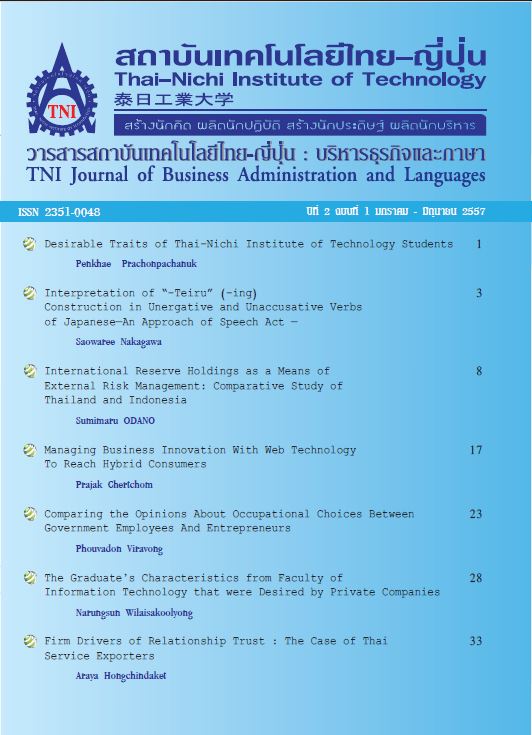Managing Business Innovation With Web Technology To Reach Hybrid Consumers
Main Article Content
Abstract
Managing business innovation with web technology is a critical issue for Thai SME (Small and Medium enterprises) entrepreneurs. The statistics of secondary data had shown that the second important factor that has had an impact on B2C (Business to Customer) model businesses is the management of online commerce and the way entrepreneurs design and create websites to reach customers.
This study proposes the guidelines for designing information architecture of an e-commerce platform (model B2C) by understanding future online society in Thailand and new consumers’ behaviors called hybrid consumers who have a second life in the internet world and interaction with companies that combine physical and virtual transactions.
Design/methodology/approach – Use of qualitative methods and specially structured interviews with fifty selected young generation individuals, web design specialists and secondary data to see the trend of technology and demand site.
Findings – The study has found that
Firstly, 74.0% of Thai companies are using the B2C type.
Secondly, significant information has shown that 70.8% of them are using ready pavkage websites which are web 1.0 technology.
Finally, the finding in this research showed that a new platform must transform the user experience for buying on-line into something personal and unique.
Originality/value – There is plenty of advice on creating a website or information architecture but no actual model or B2C platform. In terms of reaching new hybrid consumers, this study provides an understanding of them.
Article Details
Article Accepting Policy
The editorial board of Thai-Nichi Institute of Technology is pleased to receive articles from lecturers and experts in the fields of business administration, languages, engineering and technology written in Thai or English. The academic work submitted for publication must not be published in any other publication before and must not be under consideration of other journal submissions. Therefore, those interested in participating in the dissemination of work and knowledge can submit their article to the editorial board for further submission to the screening committee to consider publishing in the journal. The articles that can be published include solely research articles. Interested persons can prepare their articles by reviewing recommendations for article authors.
Copyright infringement is solely the responsibility of the author(s) of the article. Articles that have been published must be screened and reviewed for quality from qualified experts approved by the editorial board.
The text that appears within each article published in this research journal is a personal opinion of each author, nothing related to Thai-Nichi Institute of Technology, and other faculty members in the institution in any way. Responsibilities and accuracy for the content of each article are owned by each author. If there is any mistake, each author will be responsible for his/her own article(s).
The editorial board reserves the right not to bring any content, views or comments of articles in the Journal of Thai-Nichi Institute of Technology to publish before receiving permission from the authorized author(s) in writing. The published work is the copyright of the Journal of Thai-Nichi Institute of Technology.
References
SHER, P. J. & LEE, V. C. (2004) Information technology as a facilitator for enhancing dynamic capabilities through knowledge management. Information & Management, 41, 933-945.
OSMEP Thailand, Situation Report for Small and Medium Enterprises (2008) Available at : https://ams.sme.go.th/files/whitepaper2550/White-Paper-1.pdf
Y. J. Wind, V. Mahajan, (2002) Convergence Marketing: Strategies for Reaching the New Hybrid Consumer: Prentice hall
The National Statistical Office, Thailand Situation Report for Thai e-commerce (2007)., Available at https://service.nso.go.th/nso/nsopublish/thems/them_5-1-8.htmal
J. Kong (2000), A report on the ICE Conference, TechDivas, Diva Networks
D. Eylul, O.Y. SAATCIOGLU (2006), A system look for technological innovation: firm based perspective, Conference on Information System (EMCIS) 2006, July 6-7 2006, Costa Blanca, Alicante, Spain
I. Barker (2005), What is information architecture?, Available at: https://www.steptwo.com.au/papers/kmc_whatisinfoarch
E. L Morgan (2007), What is information architecture?, Available at: https://www.library.nd.edu/daiad/morgan/musings/rosenfeld-wodtke/
NECTEC Thailand (2009), Internet user in Thailand 2008, Available https://internet.nectec.or.th/webstats/internetuser.iir?Sec=internetuser
P. Kollock and M. Smith Peter (1999) “The Economies of Online Cooperation: Gifts and Public Goods in Cyberspace”
ความคิดเห็น และพฤติกรรมการใช้อินเตอร์เน็ตของเยาวชนไทย (2009), Available at: https://www.abacpoll.au.edu/BestResults/results_real-time.html
T. O’Reilly,. (2005) What is Web 2.0: Design Patterns and Business Models for the Next Generation of Software. Retrieved 3 September, 2008, Available at: https://www.oreillynet.com/pub/a/oreilly/tim/news/2005/09/30/what-is-web-20.html
G. Hammill, 2005, Mixing and Managing Four Generations by Employees, FDU Magazine Online, winter/Spring 2005.


